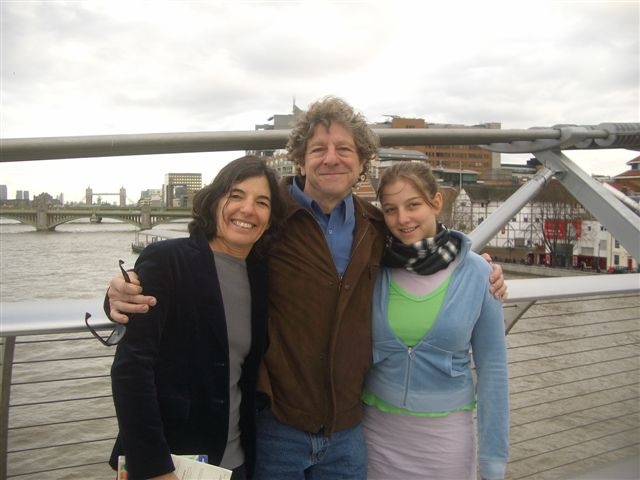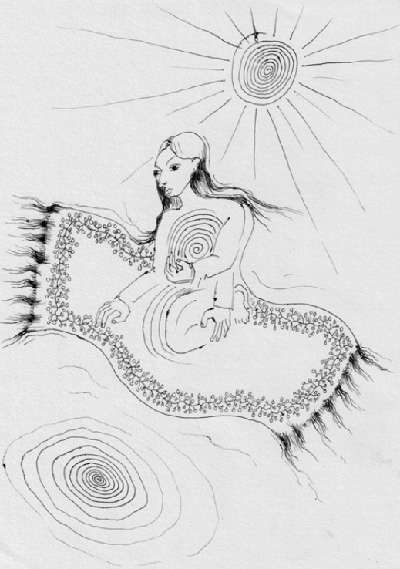My doctor tells me to close my eyes and asks me what I am feeling in my body. I tell her my chest feels heavy. She asks me to describe the heaviness—its shape and size. I tell her it’s a rectangular brick stretching from side to side. “What color is it?” she asks. I tell her it’s dark grayish, and now the pressure is so great it’s pressing into my throat. She asks more questions—“If it was an animal, what would it be?” “Would I be willing to ask it questions?”—and eventually my throat relaxes, and my chest lightens. Sometimes, I cry during these weekly check-ins that follow our more intensive work together. I am learning what it means to self-regulate.
My doctor, a nurturing and whip-smart woman in her 40s, is my ketamine guide. She is holding my hand—sometimes literally—as I try to discover new ways to deal with past losses and the terrors of the future.
Almost a year ago, I began ketamine therapy. In combination with psychotherapy, the drug has been used to help people like me deal with depression, anxiety, and trauma. Like other psychedelic medicines, which I am no stranger to, having come of age in the 1960s, it works by creating new neural pathways in the brain that will open new ways of experiencing the world, what the author Aldous Huxley famously called “doors of perception.”
I lie back on my couch with my head slightly lifted, eye mask secured, place the ketamine lozenge under my tongue, and start swishing. It takes about 15 minutes of swishing to reach peak absorption. Warmth fills my body as I move into a world where images form and create patterns. Islands rise in a deep blue sea. I am mesmerized watching buildings surface from the water, outlined in Day-Glo yellow, become skyscrapers piercing a darkening sky.
I have taken this radical and controversial step because a decade ago, within the space of a year, I lost the three people I loved most in the world—my 22-year-old daughter, my husband, and my father. While I miss my husband and my father, nothing has helped with losing my daughter. Her death remains a devastating challenge and heartbreak.
My brilliant and beloved daughter, Hope, our only child, died of an accidental drug overdose two and a half years after my husband Gus was diagnosed with pancreatic cancer, a death sentence. After Hope’s death, I was envious of my husband, who would soon be gone; still, I did everything I could to give him reasons to go on living. This included insisting that he continue going to the courthouse, where he was a highly respected judge with a community of people rooting for him.
Before Hope died, during the two and a half years after Gus was diagnosed, she was busy taking on way too much. She was always a superstar, including in her role as a community organizer for our local city councilman. Hope always aimed high. In kindergarten, when she learned about celebrating Martin Luther King Jr.’s birthday, she wanted to know what she could do that would make a big difference in the world. “What if I got all the homeless people housing?” she asked. I said that would do it, and that is exactly what she was working on when she died.
Popular
"swipe left below to view more authors"Swipe →Now, she was using and abusing drugs—this is the first time I have been able to write those words—trying to keep up while running as fast as she could. She played with fire, too readily available and unconscionably lethal, and eventually got burned. When 1,000 people showed up at her funeral, we were overwhelmed by what this wounded little girl, all of five feet tall, had been shouldering. She was being everything to everybody, trying to outrun her father’s impending death. Then she died, and I found myself obsessively trying to undo all I had ever done, desperate to create a different outcome.
As my father often advised, “When in doubt, go out.” And I did—at first with Gus and then after he died, with friends, with my dog—I just kept going. Now, a decade later, my attempts at continuing to go out and keeping superhumanly busy are not working. Compulsive calendar filling is exhausting me. Fear of emptiness is emptying me inside.
During the past 10 years, I have been in and out of grief therapy and support groups. At times, they have provided a temporary balm; other times I have felt worse. One therapist tried to enroll me in an early MDMA study. I was game, but hopes were dashed when I didn’t get in. However, it did plant the idea of using psychedelic-assisted therapy to learn how to heal from the trauma of my losses. So, when my doctor, an internist and psychoanalyst certified in ketamine therapy, announced that she was closing her primary care practice to pursue just this type of treatment full-time, I jumped at the chance to participate.
When I was the age that Hope died, I was doing drugs recreationally. Friends would “do drugs” together; back then, the drugs were milder, and we were lighter. Hope, on the other hand, was using drugs to manage the unmanageable, to stay afloat, and to relieve her psychic pain. Ironically, like Hope, I too am using drugs but it is prescriptive, controlled. Now, I sit with my pain or sometimes, I embody it. I am striving to find comfort and resolution to heal my losses, especially the loss of Hope.
Since late fall, my therapist and I have done a dozen sessions, reinforced with weekly therapy focused on how to integrate what I am learning through ketamine into my daily life. Each session, with ketamine dosing, lasts three hours. We talk for the first hour, which culminates in our coming up with a loose intention for the ketamine experience; for example, my desire to slow down or to cultivate patience and tolerance. For the second hour, I am in my own world experiencing the realm of my psyche and where the ketamine is transporting me. As I come back to Earth, for the third hour, my doctor takes notes as I recount the experience, and she asks questions that help me figure out how to integrate it into my daily life, how to slow the mind and the body.
And because ketamine is a diuretic, I put my hands on her shoulders, with eye mask slightly lifted, and we dance our way to the bathroom. We debrief. She concludes by asking what I will take away from the session. She leaves, and I write up the experience in my journal, pages and pages, another way to connect my experience with everyday living.
Since beginning ketamine therapy, I have gone from wolfing down a bowl of cold cereal as I begin my sprint through the day to discovering the joy of taking the time to simply stir my oatmeal—and there are no longer clumps of it stuck to the bottom of the pot. I observe my body, how grief takes over my chest with spasms of heaviness and how, as I put my hand over my heart, my breathing slows, and the tightness loosens.
Since losing my family, I have struggled with tremendous anxiety about the future. Gus would say, “Hope was our future; now we don’t have one.” And, now at age 73, what is the future? I think perhaps it’s learning how to be in the present.
My nightmare vision of the future used to be ending up like my grandmother who lived relatively well into her late 90s. But as she neared the end of her life, she would talk almost exclusively about her brother Max, something she had never done before. He died young, probably of asthma, and she missed him terribly.
She would cry, and I couldn’t understand. Here, now, she had a family full of loved ones as well as friends. Why was she crying about somebody who had died a very long time ago? While I don’t have the answer, I do know that if you don’t face loss, it will end up haunting you.
I have spent the past decade terrified of being alone and isolated, of having no family and outliving friends, crying to anyone who will listen about losing Hope. Now, my greatest fear is that I will be the last woman standing and I will be consumed by loss. Except I don’t want to be, and, with ketamine-assisted therapy, I am creating new pathways so I can do it differently.
During my ketamine trips, my doctor fortifies me to deal with anything “bad” that might arise. She puts together playlists so I have songs to listen to throughout each trip. She tells me to lean into the music. If something scary comes up, move toward it. Her playlists comprise songs completely unfamiliar to me, sometimes with words that repeat so I have those to anchor me when I need it.
But most often the music sounds otherworldly, from another time, certainly from other places, sometimes with vocalization, most often without. The music can become at times achingly beautiful, and each song generates a new series of hallucinations. At times they resemble knotted rope like macrame or sculptures made of bones like scrimshaw or cascading gemstones.
She also tells me not to attempt to escape from anything disturbing. Instead of running away I should surrender. Up until then, I had been hanging on to my dad’s beseeching me on the day we lost Hope to “accept it.” Now I have another, more visceral way to deal with the unimaginable. “Surrender.” I have come to love that word. During one ketamine trip, I have been entombed, inert at the bottom of the ocean, towered over by a giant red lobster. I observe and wait until the lobster swims away and the feeling of panic passes. I laugh at the lobster.
My doctor talks about human beings vs. human doings, about learning to become aware of our feelings and not trying to outrun and distract ourselves from them. And she talks about finding home. That it is within us. I like this, especially because during the pandemic, having quarantined away from my long-time home—where I got married, raised my daughter, and witnessed my husband’s death—I had lost a sense of home.
I have a recurring ketamine hallucination where I see my living room carpet being created above me. It brings color in its redness. On a recent trip, as I visualized this, I remembered when Gus and I went into Manhattan to buy the carpet. Thinking of Gus made me cry and once I started, I couldn’t stop. At some point as the trip was nearing its end and I was recounting the experience, my doctor told me to envision the carpet. I did, and when she asked me what I was thinking, I said, “It’s home.”
The carpet has appeared again and again. I am astounded that my carpet seems to be ingrained in my brain. Once, I thought of it as a magic carpet. Now I realize the carpet isn’t magic but it can lead me home, a home that I don’t feel trapped in, a home that I don’t want to plan my way out of, a home where all I have to do is be. That is my hope now.




